AMD Kaveri Review: A8-7600 and A10-7850K Tested
by Ian Cutress & Rahul Garg on January 14, 2014 8:00 AM ESTCPU Performance
I often make a big song and dance about real world benchmarks being the main focus of a reviewer. Synthetics often stress parts of the CPU and distort advantages that a CPU might have and thus not affect you or me in the same manner when using the machine normally. For 2014 I have updated my usual benchmarking set, to include more video encoding and an image converter that takes 2D images and performs algorithms to convert the data into a 3D model. Some 2013 benchmarks are still here, showing what can be done, and to bring parity to previous CPU reviews, some synthetics are also included.
Agisoft Photoscan v1.0 - link
Our new main benchmark to AnandTech is provided by Agisoft. Their Photoscan software creates 3D models from 2D images, a process which is very computationally expensive. The algorithm is split into four distinct phases, and different phases of the model reconstruction require either fast memory, fast IPC, more cores, or even OpenCL compute devices to hand. Agisoft supplied us with a special version of the software to script the process, where we take 50 images of a stately home and convert it into a medium quality model. This benchmark typically takes around 15-20 minutes on a high end PC on the CPU alone, with GPUs reducing the time.
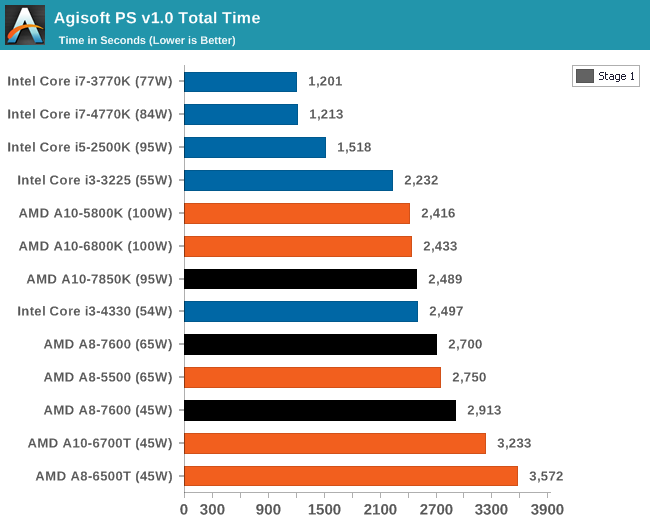
AMD suffers in overall time due to the lack of full-blooded cores and the reliance on single threaded performance in certain parts of the algorithm.
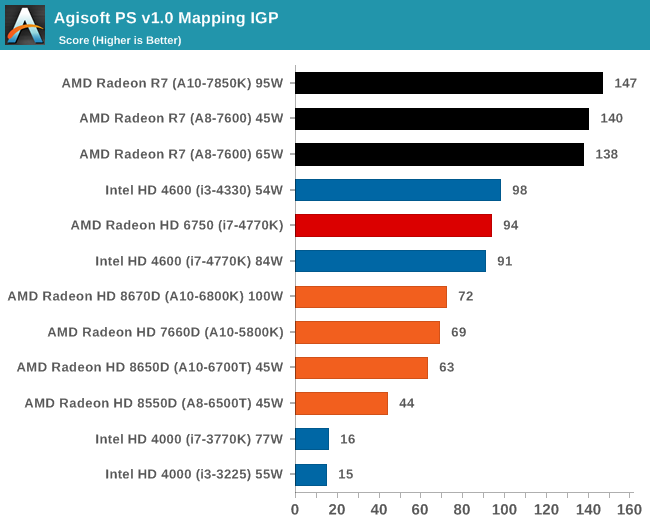
The second stage of the benchmark can be accelerated by the IGP of an APU, and as a result we can see the power of the high end APUs for this work can outshine any CPU we tested today. This is really the promise of HSA, it's just going to take a while to get there for most apps.
3D Particle Movement - link
3DPM is a self-penned benchmark, taking basic 3D movement algorithms used in Brownian Motion simulations and testing them for speed. High floating point performance, MHz and IPC wins in the single thread version, whereas the multithread version has to handle the threads and loves more cores.
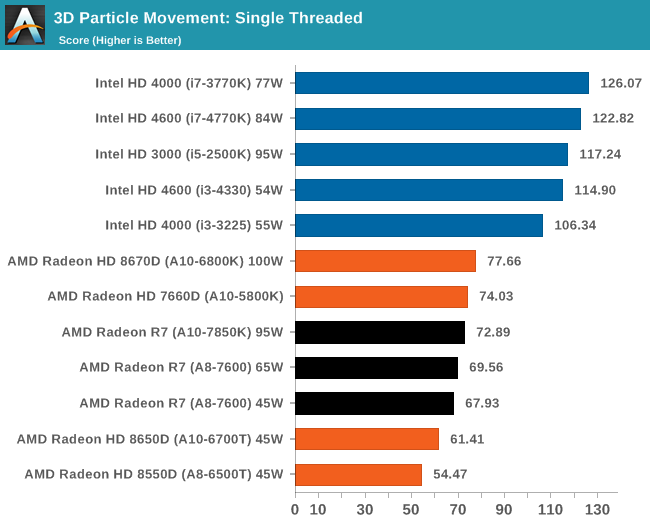
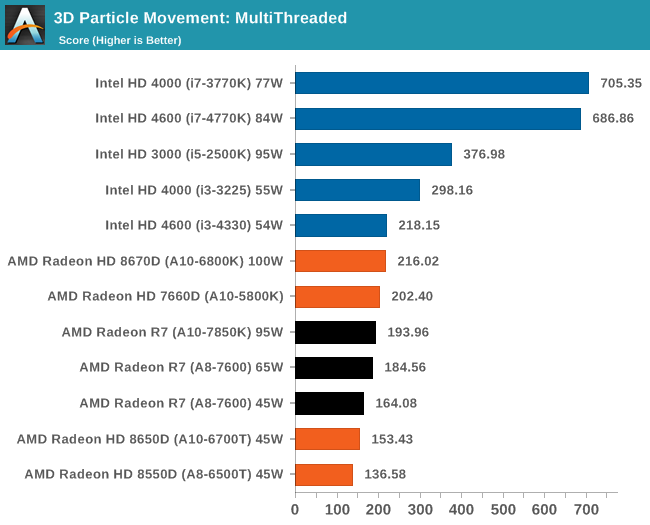
AMD is still suffering a lack of FP performance in our 3DPM benchmark.
WinRAR 5.01 - link
Our WinRAR test from 2013 is updated to the latest version of WinRAR at the start of 2014. We compress a set of 2867 files across 320 folders totaling 1.52 GB in size – 95% of these files are small typical website files, and the rest (90% of the size) are small 30 second 720p videos.
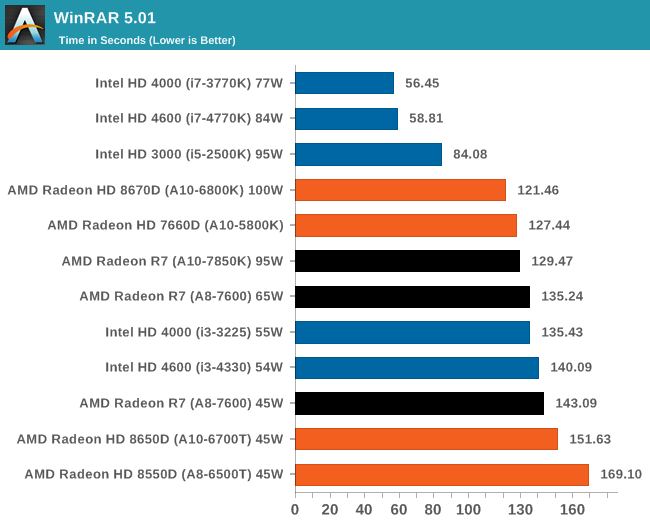
WinRAR loves IPC from the high end Intel chips, but even against the older i5-2500K there is still a deficit. The 45W Kaveri APU however is within fighting distance of its main rival.
FastStone Image Viewer 4.9 - link
Similarly to WinRAR, the FastStone test us updated for 2014 to the latest version. FastStone is the program I use to perform quick or bulk actions on images, such as resizing, adjusting for color and cropping. In our test we take a series of 170 images in various sizes and formats and convert them all into 640x480 .gif files, maintaining the aspect ratio. FastStone does not use multithreading for this test, and thus single threaded performance is often the winner.
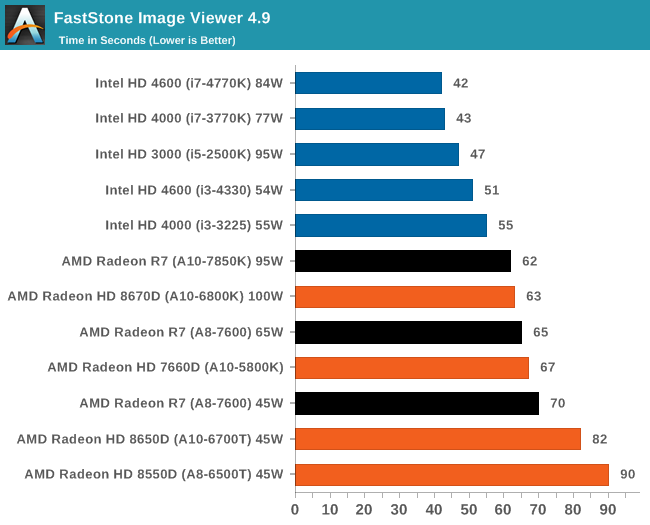
FastStone wants single threaded performance, so Intel wins here again.










380 Comments
View All Comments
ImSpartacus - Thursday, January 16, 2014 - link
"Whether or not AMD decides to develop an APU with more than 8 GCN CUs is another matter. This is a point we've brought up with AMD internally and one that I'm curious about - do any AnandTech readers have an interest in an even higher end APU with substantially more graphics horsepower? Memory bandwidth obviously becomes an issue, but the real question is how valuable an Xbox One/PS4-like APU would be to the community."I would love to see a massive APU with a Pitcairn-sized GPU. I wouldn't mind if it required a 130-150+W TDP.
I love seeing machines like the 4770R-powered Brix Pro. Valve obviously likes it as well, because it became the Steam Box sent to developers.
If I'm getting the performance of a ~$200 GPU, I'd happily pay $300 to get the CPU baked in. I'm hoping DDR4 will allow Intel or AMD to pursue this kind of market.
Haravikk - Friday, January 17, 2014 - link
I'm really interested to find out what the dual graphics performance will be like now that AMD's APUs are much more up-to-date at long last.CrossFire using an APU and a discrete GPU has been entirely underwhelming thanks to how limited compatibility was, so much so that you are always better off fitting a better discrete GPU instead. The only case it remained interesting was for small form factors where the more limited range of low-profile cards (and less aggressive pricing) meant that compatible cards weren't always so far behind newer ones.
But with GCN graphics, HSA and Mantle on the way, maybe we might finally see the benefit of pairing the two rather than just using a better pure CPU and discrete graphics. Of course, we could see some benefit already if more games used OpenCL for physics, since that at least would run quite well on an APU even if the discrete GPU still did all the heavy graphical work.
Klimax - Friday, January 17, 2014 - link
Tests are very incomplete. Where are CPU+GPU results? AMD markets APU as total solution, so as such it should be tested. So far I have seen only Luxmark set of results on TechReport and when CPU+GPU was set, APU lost, because CPU part is sufficiently weak, that not even powerful GPU was able to save it.Also some OpenCL tests are not marked whether CPU+GPU or GPU-only, which can skew things badly.
eanazag - Friday, January 17, 2014 - link
I think this article is good, but it deserves and needs some dings on it because it is on Anandtech. When we look at the benchmark section there is a disconnect between this article (the applications used for benchmarking) and the Bench portion of the website. I have enjoyed and trusted the bench methodologies used on this site over the years and find it a resource I come back to, to help me make purchasing and hardware decisions because of the bench. Over time I will find it difficult to compare findings without the bench. I have no problem with you updating the bench as what has been done with SSDs and GPUs. I just think this article overlooked what becomes the real value of what this site offers if you overlook the ongoing bench portion of this site. I looked in the bench and haven't really seen a whole lot of anything recent on AMD APUs in the bench. That's my first ding.I suspect that if Anand was excited about AMD's release and had reviewed this product we would have gotten a better appreciation of what Kaveri brings to the table. I got the message that the 45W part is a very good in its segment and may be something worth considering, but I did not get what is mentioned in the article. What's the reality of running Kaveri on 1080p? You gave us the high settings, but no one with any sense is going to settle for less than 12 fps. So what are the realistic settings that will give us 20/30+ fps (game depending) performance. What are we really able to work with. I understand Anand is busy and likely not excited about another AMD CPU product release. I get it; it is hard to get excited about desktop and higher wattage laptop parts for AMD because they have been lack luster & underwhelming year over year for so long. I think this product fits in more than just the 45W space, but I didn't get that answer. I am still wondering, which is not what I would normally get at Anandtech. Normally, I would be getting more than I expected from a review. That's my second ding.
This next is a general ding about the bench. You guys do great work here. I am on here about every day. The bench could use some tweaking in relation to the CPU and GPU between laptop and desktop and to an extent mobile. I want to know how a mobile GPU/CPU matches up to a desktop variant. Sometimes I even want to know how they match up in mobile devices (tablets and phones). I have gotten some of that info from articles, but it is rough matching up that info in the mobile (laptop) bench. Sometimes I do want to look at specific laptop info, but most of the time I am just considering the guts of the device. I decide between the trade offs of desktops to laptops in applications. The information is here, but it is not easy to compare. This is an opportunity for improvement, especially given the nature of the changing technology landscape.
This is an addendum to the bench issue. I'd like to compare server processors too. It seems to me like in some niches we might start seeing server parts fill over the places where those highend desktop parts were. I already see this in AMD. Intel is on the cusp of this also. This is something to consider. I'd also like to see some more enterprise items covered in general. AMD is selling ARM servers already? Where have I been? And there are ARM based linuxes available.
Thanks for the great work and timely info.
HisDivineOrder - Saturday, January 18, 2014 - link
"The point I am making with this heart-warming/wrenching family story is that the Kaveri APU is probably the ideal fit for what he needs. Strap him up with an A8-7600 and away he goes. It will be faster than anything he has used before, it will play his games as well as that new HD 6750, and when my grandmother wants to surf the web or edit some older images, she will not have to wait around for them to happen. It should all come in with a budget they would like as well."OR you could buy him a cheapo dual-core CPU from Intel plus a used mid-range card from a year or two ago.
Far better performance for only a bit more. There is an argument forthese APU's in gaming and it's for those who want to game with something like a Gigabyte BRIX-sized computer that trades performance for size.
Performance per dollar does not favor the APU simply because you can get so much more performance ignoring these APU's altogether.
NinuGie - Saturday, January 18, 2014 - link
such wow much fail. until APU comes in desktop format there will always be better alternatives. i want to see an APU compact format and similar to what they did on PS4. shared fast RAM .until then,they suck. i mean this is so bad implemented. and they advertise it for gamers lol. even if you CF the apu with a supprted gpu ,a HD 7770 is better so no thank youarthur42 - Sunday, January 19, 2014 - link
The A10-6700T is in good supply in Europe; I'm running one for months now.aidnr - Monday, January 20, 2014 - link
I'm pretty impressed with what they've done here, it looks like it is pretty evenly matched with Intel's offering - http://versus.com/en/amd-a10-7850k-vs-intel-core-i...Will be interesting to see how widely adopted Mantle is, seems pretty nice.
samal90 - Monday, January 20, 2014 - link
Can someone explain to me how come AMD is able to make an incredible APU capable of running games at almost 60fps on the new consoles but can't make a desktop APU to do so? Why can't they use the same architecture? Maybe I'm missing something...but I'm just wondering.meacupla - Wednesday, January 22, 2014 - link
Because PS4/XB1 is not limited to using FM2+ socket, because they use a much slower CPU portion in PS4/XB1 and because of thermal limits.